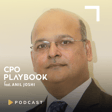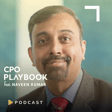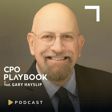Introduction to the CPO Playbook Podcast
00:00:05
Speaker
Hello everyone, I'm Felicia Shakiba and you're listening to the CPO Playbook Podcast. Join me and my guests as we feature insightful conversations with HR leaders, people scientists, and executives from diverse industries and functions, offering valuable perspectives on the future of work.
Innovative HR Strategies
00:00:23
Speaker
Discover a unique outlook on navigating the complexities of the modern-day working world. Exploring innovative strategies in talent management and corporate culture from the chief people officer's perspective. Tune in to stay ahead of the game when it comes to all things people related.
The Cost of Poor Communication
00:00:44
Speaker
Effective communication within organizations has become not just a desirable skill, but a fundamental necessity. Axios HQ's recent calculation of the cost of poor communication in its 2023 State of Essential Workplace Communication report illustrates that ineffective communication costs organizations $2 trillion per year or around $15,000 per employee in lost productivity.
00:01:13
Speaker
The ability to convey thoughts, ideas, and information clearly and concisely is pivotal to the success of any team, department, or company. In recent years, communication challenges have grown more complex due to the three key factors. Firstly, globalization has led to increased interactions with diverse cultures, raising the risk of misunderstandings. Secondly,
00:01:36
Speaker
Hybrid work models have blurred the lines between physical and digital workspaces, posing difficulties in maintaining clear communication. Lastly, the digital age's information overload inundated employees with messages, making it a challenge to filter and prioritize information effectively. These factors collectively underscore the need for adept communication strategies in today's organizational landscape.
Interview with Matt Abrahams
00:02:04
Speaker
In this episode, I'm interviewing Matt Abrahams, a Stanford University lecturer in organizational behavior, acclaimed for teaching courses on strategic communication and virtual presenting. You might know Matt from his popular podcast, Think Fast, Talk Smart. Matt, I'm a huge fan of your podcast and I'm incredibly grateful to have you on the show. Welcome.
00:02:31
Speaker
Thank you so much. I am excited to be here with you. Matt, leadership communication is often the toughest to nail and also the most critical. So could you share some practical strategies for leaders to align their messaging with organizational goals and values?
00:02:50
Speaker
That's a really important question, and thank you for asking it. I first believe that communication is operationalized leadership. How you lead is through your communication. So your question is fundamental. It's how do I align my approach to leadership, the company's goals and objectives, and the needs of the people I'm speaking with?
00:03:14
Speaker
So it first and foremost starts by understanding those you're speaking to. You really have to understand your audience and know what's important and relevant to them. So when you're speaking to a line employee, what's important and relevant for them might be very different than when you're talking to your direct reports. So as a leader, we have to first think about what's most relevant and important to the people we're speaking to.
00:03:38
Speaker
and then think about how can we craft messages that align with the needs of those I'm speaking to and connect to and support and reinforce the mission, vision, values of the organization, the goals that we're trying to achieve, and our own personal way of being in the world. So it starts with the audience, then you have to bring in yourself and the goals that you're trying to achieve.
00:04:03
Speaker
And I love that because you started off really strong, which was the mission and vision and values, which I think are the most important.
Building Effective Communication Infrastructure
00:04:13
Speaker
And so in a world of information overload, how can organizations effectively prioritize and streamline their communication to ensure that the key messages are not lost in the noise?
00:04:27
Speaker
Absolutely. When I work with organizations in a consulting capacity, I often talk about setting up an effective communication infrastructure, and that's the people, the process, and the tools that are involved. So we have to step back first and see communication is critical and essential to success. Often people see it as a necessary evil to get work done, and I obviously think that's the wrong way to view it.
00:04:51
Speaker
So we have to make sure that people understand what is important and the value of communication in the organization. And this starts before you even bring people into the organization. It's how you interview them. It's what you put on the job descriptions. People have to understand communication is important. You should be interviewing people and asking about their approach to communication.
00:05:10
Speaker
and then reinforcing the value of communication, one by role modeling from senior leaders. At the end of every meeting, people should be taking a few moments to just reflect on the quality of communication, not rehashing what was said, but reflecting on the quality. As part of performance reviews and everyday conversation, communication should be discussed.
00:05:28
Speaker
So we have to deal with the people part. We have to also think about the process part. How do we prioritize what's most important? So as senior leaders, as managers, we need to be constantly thinking about what are our priorities and how do we package that up in a way that's meaningful. And that brings us to the third part, which is tools. And the tools piece is where do we tell people to go to get the most important information? I mean, the average knowledge worker
00:05:54
Speaker
has five or six different communication inputs, right? Everything from Slack to email to texting to phones. How do we know where to go to find the most important things? So we have to not only prioritize the message, we not only have to have people who are focused on important communication, we have to give them guidance as to which tools to refer to.
00:06:13
Speaker
So it's a lot of work, but once you put those in place, it makes life so much easier. I am often brought into triage organizations that have not done that, and we're having to dig them out of the hole they've put themselves in. So if you can upfront build this communication infrastructure, it should help.
00:06:30
Speaker
I think that this is such an important aspect because people are always focused on the content, which they should be. The how they communicate is so critical, and I think it's really easy to focus so much on the content and not enough on the how, and then the content really gets lost in an organization.
00:06:52
Speaker
especially when you are looking at remote work and hybrid models. So what advice would you offer to maintain those clear and effective communication strategies in a virtual setting?
00:07:06
Speaker
A lot of what I would say applies to virtual and in-person synchronous and asynchronous.
Keys to Virtual Communication
00:07:11
Speaker
I have to give all the caveats now these days. So first, you need to have a clear goal. And your goal is predicated on what you know about your audience. So a goal to me has three parts. No, feel, do. What do you want people to know? How do you want them to feel about it? And what do you want them to do? And you have to be very clear on the action.
00:07:27
Speaker
you have to be very clear on evoking the emotion so no feel do regardless of virtual or in person once you have that done you have to think about what's the most effective way to structure the information i am a huge proponent of structure to me structure is just a logical connection of ideas it is not a list it is not just a series of bullet points.
00:07:47
Speaker
Find a structure that works, for example, problem-solution-benefit. Here's the problem we're trying to address, here's the suggested approach or solution, and here are the benefits we anticipate if we implement this solution. Having that structure and packaging information up that way makes it more clear and more concise. When we are virtual, we must be more clear and concise.
00:08:11
Speaker
people are much more distracted when they are virtual. So we have to package things that are clear, concise, and relevant. If people understand the relevance, they will pay more attention to it. So when we're virtual, we have to do more around concision of messages and around relevance and being engaging. Again, because people are more easily distracted when they are remote, not around others, and on a device that has lots of other interesting things to engage their attention.
00:08:39
Speaker
Wow, I think you nailed it because it is the obvious truth of how we are communicating in a virtual world. So that makes a lot of sense to me. And being more concise and being more engaged or having that structure that you just shared, I think would go a long way. So in your experience, what are the common communication pitfalls that organizations should be aware of? Like how can we avoid them?
00:09:07
Speaker
To my mind, attention is the most precious commodity we have in the world today. And if I'm a leader of an organization, a manager of a group, I am working to help my team and myself prioritize where we put attention. So that's the number one thing. And you mentioned it, you alluded to it. It's possible to put out too much information. Now, you want people to understand what's going on. You want to be transparent. But you have to think about how do I put that information out into the world? How can I package it in a way that it's not overwhelming?
00:09:37
Speaker
Are there ways that I can maximize people's time on task? I have a huge issue with meetings that serve the sole purpose of just updating everybody. I think there are many more effective ways to update people so we can use our meetings for what they're good at, which is collaborating, ideating, sharing information, and giving feedback.
00:09:58
Speaker
So as a leader, it's all about prioritizing.
Managing Information Overload
00:10:01
Speaker
It's about maximizing people's attention and time on task and still fulfilling the need to be transparent and helping people understand how their work fits into the bigger pictures. It's about making people efficient and effective, but helping them understand the relevance as well.
00:10:18
Speaker
You know, Microsoft is a little bit famous for adding this five minute cushion, either before or after a meeting. And there's a study out there that shows the brain activity on if they're full or burned out by the end of the day, if they're going either from back to back meetings or they're having that five minute cushion. You've seen this study, I'm sure. It sounds like what you're saying is that having that breath
00:10:43
Speaker
before or after meetings to prioritize and maybe share an agenda even next week or the next day gives that download and actually maximizes the communication and prioritizes the time and attention for the meeting when we have them face-to-face. So I think that's really relevant and very valuable advice. So thank you for that.
00:11:08
Speaker
Yeah, you're welcome. And I think you're right that we have to build in time for people to regenerate and recoup. One of my colleagues at Stanford's Business School, Jonathan Lavave, did this fascinating study, he and others, looking at when people come up for parole, somebody who has been jailed comes up for parole.
00:11:28
Speaker
It turns out a big factor in is somebody going to be paroled or not, given that they've met the criteria for parole, the judge makes the decision yes or no. You are more likely to get a yes, that is where the judge really considers and weighs things when they are arrested, when they are not fatigued by all the decisions they have to make.
00:11:50
Speaker
And so the advice that Jonathan gives sort of tongue in cheek is that you definitely want to be in the morning or right after a meal if you're being paroled because you are not taxing the judge's way of thinking. I believe applies to the way we meet and work. If you have an important meeting,
00:12:08
Speaker
Perhaps scheduling it as the fifth meeting of the day for the executive that you're meeting with, perhaps you wait a day and put it earlier in the day. You might have a completely different experience and get a different level of input and engagement. So this notion of taking into account your listeners or the people you're engaged with state of being, I think really matters.
00:12:28
Speaker
I love that. I think that's great advice. Let's take another turn here. As we both know, organizations, whether they're small or large, they don't always sit in the same country. And so can you discuss the role of cross-cultural communication in today's globalized organizations and provide insights on fostering that cultural sensitivity within teams or even across
Cultural Awareness in Global Organizations
00:12:53
Speaker
So intercultural communication is really challenging for many, many reasons. Different cultures. And when I talk about culture, I'm not just talking about globally where people are physically seated on a map. Organizations themselves have different cultures. The way that IBM and Cisco interact is very different than the way Atlassian and small startups interact. They have their own different cultures.
00:13:16
Speaker
We need to be very mindful of that. Another colleague at Stanford's Business School, her name's Michelle Gelfin, studies culture and looks at how communication plays out as among many things she looks at. And she looks at how some cultures are tighter and others are looser in terms of just expectations, what they say, how they say it.
00:13:33
Speaker
So we need to take this into account. So at the highest level, we just have to be aware that different cultures do different things differently. And we need to be open to different ways. And the big thing is our way, whatever that is, wherever you are, is not necessarily the right way. It is just a way. And we need to be open and respectful of other people's ways of doing it. So if I were leading an interculture or a team that spanned different cultures,
00:13:58
Speaker
One of the very first things I would do is spend some time setting ground rules and best practices for how we're going to work together, getting us some agreement on ways to do it and be open to perhaps my way, not being the right way and listen to how other people and then just get agreement. So we're all playing from the same playbook. That's how I think we make things more effective. What do you think or what is an example that you might implement as a way to
00:14:27
Speaker
First and foremost, one of the things I would do is talk about how we all contribute in meetings, both when we're meeting live and as well as virtually. Different cultures have different expectations for how one contributes, right? So in one culture, it might be the case that it is not assert your idea right away. It's collect a bunch of ideas, reflect on it, and then comment. So we might, as a team,
00:14:51
Speaker
need to set up a mechanism by which we all agree that new ideas will be brought to the table and discussed and then give time for others to reflect and then come back to them. We just have to make sure that we're aware. Here in North America, we tend to be very assertive in our positions
00:15:08
Speaker
We are often rewarded for bringing in new ideas and contradicting or commenting on others' ideas. And in other cultures, that might be seen as rude or inappropriate. And we certainly don't want to signal to people from those cultures that their ideas aren't valued just because they're not comfortable jumping in and interrupting and giving feedback directly. So we have to be mindful. In your book.
00:15:31
Speaker
Launching this month, think faster, talk smarter. You address spontaneous speaking. So what does that look like in an organization and how might leaders find it beneficial?
Developing Spontaneous Speaking Skills
00:15:44
Speaker
So I would just ask everybody to just look around at the communication you do on a daily basis in your personal and professional life. Most of it is not planned. A planned presentation is or a planned communication is a presentation, a pitch, a meeting agenda. Most of our communication happens in the moment. If somebody asks a question or asks for feedback or you make a mistake and you have to recover or you're making small talk or somebody says, hey, you know her better than I do, will you introduce her around? I mean, all of a sudden we are put on the spot to respond. And yet,
00:16:14
Speaker
Most of our training, if we get any training in communication, is all about planned communication. And that's certainly important. I've spent my career teaching people how to give planned communication. But we need to also spend some time strengthening our muscles in those spontaneous moments that can really throw us off and have often high stakes for what we're trying to accomplish.
00:16:35
Speaker
Effective meetings are where a lot of the decisions happen, especially in cross-functional projects. What strategies can leaders employ to ensure meetings result in clear takeaways and actionable outcomes? And how might an organization scale these strategies?
00:16:53
Speaker
I love this question.
Effective Meeting Strategies
00:16:55
Speaker
I think meetings are amazingly important, yet are so poorly executed. People who spend their whole academic career studying this, I think we should all listen to what they say and do. I'm going to start at the beginning. First, the purpose of the meeting needs to be very clear.
00:17:11
Speaker
And often, meetings are band-aids for bigger problems that exist. So there's a problem in how we implement or how we bring a product to market. What do we do? We just keep throwing meetings at them to try to fix the problem. Get to the systemic issue at hand. Make the changes. Meetings are not band-aids. Second, when you call a meeting, make sure you figure out who the right people are, who should attend. Often, we will invite more people than are needed. Third,
00:17:39
Speaker
How you name your meeting, how you invite people to your meeting really matters as well. I think the most underutilized expectation setting tool for effective meetings is the meeting invite. We slap a name on it, a URL or a room location and that's it.
00:17:54
Speaker
You can do a lot of work in a meeting invite you can set the agenda if you're using specific tools especially a virtual you're using the whiteboard reactions buttons tell people put links to tutorials so people know how to use the tools. I always put a provocative question or a challenge in my calendar invite so when people come to the meeting we start with that.
00:18:15
Speaker
People don't like going to meetings the way we start most meetings is reviewing the previous meeting how ludicrous is that you don't want to be here so i'm gonna remind you of the previous meeting where you didn't want to be there either that's silly. Rather start with something engaging keep on track keep on time have a facilitator who might not be the leader.
00:18:33
Speaker
in the room, making sure that voices are heard. If you're hybrid, people who are remote, their voices are being brought into the room. That can lead to better time management, better focus on goals. When your meetings are done at the end of the meeting, take a few moments to review the quality of the meeting, not rehash what was said. But what could we do to do something different or better? You know that definition of insanity, doing the same thing over and over again, expecting different results. We should not run our meetings like that. We should make adjustments to make them better.
00:19:03
Speaker
And then finally, in one place, post all of the actions that came out of it. If you're taking notes or minutes, post them all in one place. Train people to check those out to make sure everything was captured appropriately. I'm sorry, I get very passionate about meetings. I think we waste meetings. I think meetings could be so much more effective. And you gave me permission to get up on my soapbox. So thank you.
00:19:24
Speaker
Oh my gosh, don't you dare apologize. That was so critical. Everything that you just said, because I feel like people have a lot of opinions about meetings, but rightfully so because they are the biggest time suck if they are not done correctly and every minute counts. I mean, I know that I've been part of a hundred thousand person organizations and
00:19:51
Speaker
There are so many critical things that need to be shared with critical people. And sometimes I can't get them on the calendar for another week or two weeks. And that attention is so valuable. And so having that structure or those strategies
00:20:08
Speaker
to where you're creating this well-oiled machine of communication culturally is so important, so critical, and the time is just golden. So I thought that was awesome, everything that you just shared. One other thing I wanted to touch on was anchor stories.
Using Anchor Stories to Enhance Culture
00:20:25
Speaker
And I would love for you to share what is an anchor story? What is the significance of it in leadership communication? And can you provide examples
00:20:34
Speaker
of successful anchor stories and how they have positively impacted organizations. So an anchor story is nothing more than a story that is fundamental and foundational to a group, to an organization. They are things that ground people into the way of thinking, and it often reflects the values, mission, and vision of the organization.
00:20:57
Speaker
So many stories take their founding story as an anchor story or a particular challenge or adversity that the company or a particular individual who had to overcome or has addressed. And I think it's important for all of us in our own lives, but also in our organizations and teams to think of what are some of those foundational stories.
00:21:17
Speaker
that you can tell. And as part of indoctrination or bringing people on board and getting people part of the company, you share those stories and you ask people to share their perspectives on those stories.
00:21:29
Speaker
I worked for a company many, many years ago before I switched back to academia. And we had some really important foundational stories about how the company came together, the mission that we had, and some of the initial efforts that were put forth, both successful and unsuccessful. Because you can learn from failure as well, and you can tell those stories. This very same company had failure Fridays, where every Friday, when we were rapidly growing, you would come together and you would share a failure you had that week.
00:21:58
Speaker
such that others would hear and the executives would pick the best failure of the week and reward it. You actually got a reward for failing because they were asking us to try new things, be disruptive, and you're going to make mistakes when you do that. But it also taught people not to make the same mistake. So these anchor stories, established culture, they connect people and they paint a picture of what is acceptable and expected throughout the team.
00:22:24
Speaker
Yeah, I think they're extremely powerful. I think a lot of leaders forget the storytelling capability can make such a great impact on both the productivity, but also just the overall engagement of employees and the people that work there. I think they're so important from a leadership's perspective. And so as a lecturer at Stanford Graduate School of Business,
00:22:46
Speaker
one of the top business schools in the country, what are some key takeaways or lessons from your strategic communication and virtual presenting courses that professionals can apply in their day-to-day work?
00:23:00
Speaker
So we've covered several of them, actually, but I'll reinforce them here. Know your audience. It's critical to understand your audience. Tailor your messages to them. Make your content accessible. I don't like to talk about dumbing things down or oversimplifying. We have to make content accessible. And you do that through telling stories, by breaking things down into pieces, by using analogies. My students work very hard to take complex ideas, technical, scientific,
00:23:29
Speaker
financial and make them accessible. So we have to also think about how we deliver our messages, the channels and the way in which we say it. You can have great messages, but if they're not delivered appropriately or properly, you can actually work against yourself. So how you say something matters. We have to practice. If it's something you're standing up and presenting, if it's something you're doing virtually, you should practice. You should record yourself. You should get feedback. How you say something in some cases is more important than what you say.
00:23:58
Speaker
I think that is great advice, Matt, and it's been amazing to have you on the show. Thank you so much for your time. I can't wait to share this with the world, and I'm excited to read your book.
00:24:13
Speaker
Thank you so much. It has been a true pleasure to chat with you. Thank you for the opportunity and I wish you well. That's Matt Abrahams, lecturer at Stanford University Graduate School of Business and podcast host of Think Fast Talk Smart.
00:24:34
Speaker
If you like today's podcast, we have more podcasts on innovative HR strategies, talent management, organizational culture, and more, and how to navigate the complexities of modern day HR. Find them at cpoplaybook.com slash podcasts or search CPO Playbook on Apple Podcasts, Spotify, or wherever you listen.
00:24:57
Speaker
Thanks for listening to the CPO Playbook Podcast. We'll be back with a new episode next time. I'm Felicia Shakiba. If you love CPO Playbook, the best thing you can do to support us is become a subscriber. You can do that at cpoplaybook.com slash podcast. That's cpoplaybook.com slash podcast. If there's an episode you loved, please share it with a friend.
00:25:24
Speaker
And if you have an idea you would like us to talk about or a guest you'd like to nominate, visit cpoplaybook.com slash contact us to suggest an idea.




















